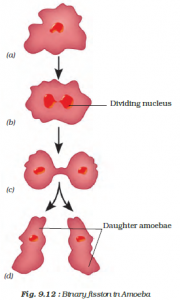Reproduction in Animals
Reproduction:Reproduction (or procreation or breeding) is the biological process by which new individual organisms – “offspring” – are produced from their “parents”.
Reproduction is the process by which living organisms produce more living organisms of its own kind.

Reproduction in Animals
Mode of Reproduction:
There are mainly two types of reproduction in living organisms.
1. Asexual Reduction: The process of reproduction in which new individuals are produced from a single parent. E.g. microorganisms.
Asexual reproduction is found in the single–celled organism such as the archabacteria, eubacteria etc. Many plants and fungi reproduce asexually as well.
- Sexual Reproduction: The process of reproduction in which two individuals are involved to produce a new individual. E.g. Human, tiger
Sexual Reproduction:
the production of new living organisms by combining genetic information from two individuals of different types (sexes). In most higher organisms, one sex (male) produces a small motile gamete which travels to fuse with a larger stationary gamete produced by the other (female).
Reproductive Organs in Humans:
- Male Reproductive Organs:
A pair of testes (singular, testis), two sperm ducts and a penis, these are the male reproductive organs. The testes produce the male gametes called sperms. Millions of male gametes (sperms) are produced by the testes. Though sperms are very small in size, each has a head, a middle piece and a tail. Sperm is a single cell with all the usual cell components.
2.Female Reproductive Organs:
A pair of ovaries, oviducts (Fallopian tubes) and the uterus, these are the female reproductive organs. Ovary produces female gametes called ova (eggs). In human beings, a single matured egg is released by one of the ovaries, into the oviduct every month. Uterus is the part where development of the baby takes place. An egg is also a single cell.
Fertilization:
The process of fertilization is fusion of a male gamete (Sperm) with a female gamete (Ovum) is called fertilization. Zygote is formed after fertilization.
Types of Fertilization:There are two types of fertilization in animals, external fertilization and internal fertilization.
1. Internal Fertilisation: When fertilization takes place inside the animal’s body, it is called internal fertilization. Internal fertilization occurs in many animals including humans, cows, dogs and hens.
2. External Fertilisation: In this type of fertilization, the fusion of a male and a female gamete takes place outside the body of the animal’s body is called external fertilization. It is very common in aquatic animals such as fish, starfish, etc.
Example: During spring or rainy season, frogs and toads move to ponds and river. When the male and female come together in water, the female lays the eggs, the male deposits sperms over them. Each sperm swims randomly in water with the help of its long tail. The sperms then come in contact with the eggs.
Development of Embryo:
The zygote divides rapidly and forms a ball of cells. The cells then begin to form groups that develop into tissues and organs of the body. This structure is called embryo. It then gets embedded in the wall of the uterus for further development. This process is called implantation. The embryo gradually develops its body parts such as hands, legs, eyes, etc. The stage of the embryo in which all the body parts can be identified is called a foetus. When development of the foetus is complete, the mother gives birth to the baby.
Formation of Egg Shell in Hens:
Internal fertilization takes place in hens. After fertilization, the zygote divides continuously and moves to the oviduct. As it travels down, many protective layers are formed around it. The hard shell in a hen’s egg is one such protective layer. After the hard shell is formed, the hen finally lays the egg. The embryo takes about 3 weeks to develop into a chick. The hen sits on the eggs to provide sufficient warmth. After the chick is completely developed it bursts open the egg shell.
Viviparous and Oviparous Animals:
1. The animals which give birth to young ones are called viviparous animals. Examples- Human being, dog, cows.
2. Those animals which lay eggs are called oviparous animals. Examples – hen, frog etc.
IVF (In Vitro Fertilisation) and ET(embryo transfer)
IVF refers to in vitro fertilisation and ET refers to embryo transfer. Gametes from the male and female are collected hygienically and induced to fuse in the laboratory set up under simulated conditions. The zygote formed is collected and is introduced into the uterus of a host or surrogate mother at the appropriate time (secretory phase). Early embryos (up to 8 cells) are generally transferred to the fallopian tube, whereas embryos with more than 8 cells are transferred to the uterus.
Young Ones to Adults:
1. Direct Development: When the young ones of an animal resemble the adult, then direct development takes place, e.g. hen, man, monkey, etc.
- Indirect Development: When the young ones of an animal do not resemble the adult, then indirect development takes place, e.g. frog, butterfly, silk moth, etc.
- Metamorphosis: In case of indirect development, transformation of young ones into adult through drastic changes is called metamorphosis. Larva of butterfly undergoes metamorphosis to become a butterfly. A tadpole undergoes metamorphosis to become a frog.
Asexual Reproduction Methods: The process of reproduction in which new individuals are produced from single parent. Example – Microorganisms.
1. Budding: This reproduction method is seen in those multi cellular animals which are highly simple in structure. A small bud or bulge develops on the body. After developing the bud, it gets detached from the parent’s body to begin life as a new individual. Since new individuals develop from the buds, this type of asexual reproduction is called budding Examples: Hydra and sponges.
- Binary Fission:This method of reproduction is seen in unicellular animals, example- amoeba. In this method, an organism divides and forms two daughter cells. First the nucleus divides and forms two daughter nuclei. Then the cytoplasm in the mother cell divides into two daughter cells. This leads to the formation of the two daughter cells each having a nucleus and its own cell organelles which then develop into a fully formed adult. Example- paramaecium, leishmania etc.
Cloning:
1. Cloning is process of production of an exact copy of a cell, any other living part, or a complete organism. Cloning process of an animal was successfully performed for the first time by Ian Wilmut and his colleagues at the Roslin Institute in Edinburgh, Scotland. They cloned successfully a sheep named Dolly.
- During the process of cloning sheep named Dolly, a cell was collected from the mammary gland of a female Finn Dorsett sheep. Simultaneously, an egg was collected from a Scottish blackface ewe. The nucleus was removed from the egg. After that, the nucleus of the mammary gland cell from the Finn Dorsett sheep was inserted into the egg of the Scottish blackface ewe whose nucleus had been removed. Then this egg was implanted into the Scottish blackface ewe. Development of this egg followed normally and then finally Dolly was born. It was found to be absolutely identical to the Finn Dorsett sheep from which the nucleus was taken.
Exercises
1.Reproduction is termed to be a biological process in which organisms give birth to their off springs.It helps in increasing population continuing a particular species or race.Reproduction is meant for the survival of all living things.
- The fusion of male and female gamete is called fertilisation. Firstly the male gametes or sperms are released from the male reproductive organ called the penis then the sperms released to enter the female body through the vagina.From the vagina, sperms travel through the fallopian tubes where they meet the eggs.Then from there on, the process of fertilization takes place in the fallopian tube.The male gamete cell (sperm) and female gamete cell (egg) fuse together to form a zygote.The zygote divides rapidly to form a group of cells called morula, which becomes the embryo after approximately five days. The foetus is present for about eight weeks after the fertilization.
- a) (i) in female body.b) (ii) metamorphosis c) (iii) two
- a) Falseb) Truec) Trued) Falsee) Truef) Falseg) Falseh) Truei) Truej) False
- Zygote:
- A zygote is an embryo with only one cell. The zygote forms when the sperm fuses with the Ova.in humans, the zygote drifts down the ovary until it starts mitosis, forming a multicellular embryo. The start of mitosis takes place in less than three days, for humans.
Foetus
- It is the last developmental stage of an organism A foetus is an embryo made of many cells that has already formed recognizable tissues and organs. In humans, the foetus is already formed after the first trimester (three months).
In this type of reproduction, the offspring arises from a single organism without the fusion of male and female gametes. It never changes the number of chromosomes.
- Binary fission in amoebaAmoeba is a shapeless tiny unicellular organism that has a porous cell membrane which encloses the cell organelles and cytoplasm. Amoeba reproduces by the common asexual reproduction method called binary fission. After replicating its genetic material through mitotic division, the cell divides into two equal sized daughter cells. The genetic material is also equally partitioned; therefore the daughter cells are genetically identical to each other and the parent cell. In this process, the nucleus of the Amoeba first divides to form two daughter nuclei by the process of Karyokinesis. After the nucleus has divided into two, the process of Cytokinesis takes place in which the cytoplasm in the mother cell divides into two daughter cells. This leads to the formation of the two daughter Amoebae cell having a nucleus and its own cell organelles.Karyokinesis is the process of the division of the nucleus. It corresponds to the separation of the daughter chromosomes into two daughter nuclei. Karyokinesis is usually followed by Cytokinesis.
Cytokinesis is the process of the division of the cytoplasm. It corresponds to the separation of the daughter nuclei into two daughter cells. Cytokinesis occurs immediately after mitosis.
.

Budding in hydra
- Organisms such as hydra, use regenerative cells for reproduction in the process of budding.In hydra, first a small outgrowth called bud is formed on the side of its body by the repeated mitotic divisions of its cells. Thus bud them grows gradually to form a small Hydra by developing a mouth and tentacles. And finally the tiny new Hydra detaches itself from the body of parent Hydra and lives as a separate organism. In this way, the parent Hydra has produced a new Hydra.
- In the female reproductive organ, the embryo gets attached to the uterus.Once it gets attached, there occurs the formation of body parts like legs, hands, eyes etc.The embryo is then called a foetus.
-
Metamorphosis is a biological process by which an animal physically develops after birth or hatching, involving a conspicuous and relatively abrupt change in the animal’s body structure through cell growth and differentiation.for example in frogs.

. 9.The process of the internal fertilization takes place inside the female body, and the offspring develops there only, while in external fertilization this process happens outside the body that is in the external aquatic environment. Internal fertilization is of three types – Oviparity; Viviparity; Ovoviviparity.
- Across
1) Fertilization
6) Internal
7) Buds
8) Ovary
Down
2) Testis
3) Zygote
4) Oviparous
5) Binary

